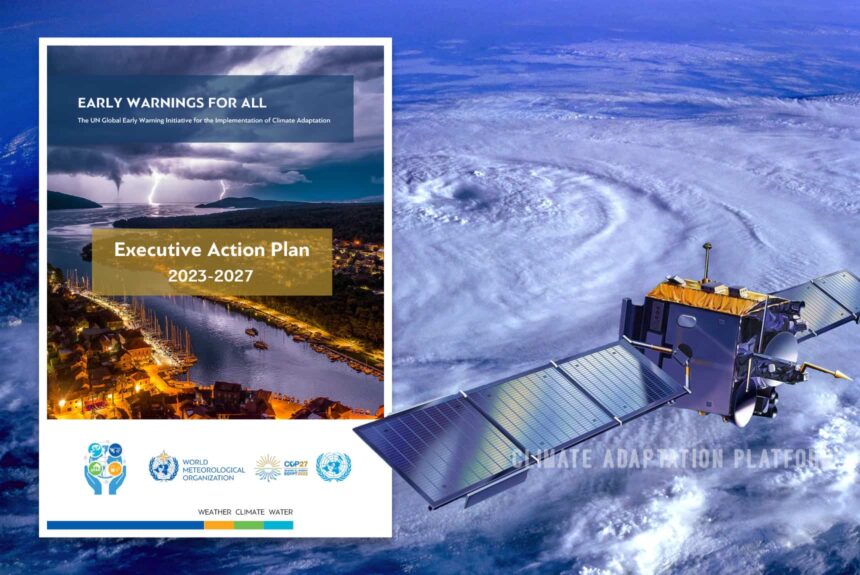Scientists worldwide agree that climate change is increasing the frequency and intensity of extreme weather events and that those impacts will continue to worsen. Reducing climate change’s effects will entail slashing our GHG emissions and implementing climate adaptation measures.
Early warning systems (EWS) are key elements of climate change adaptation and disaster risk reduction. Its role is to avoid or reduce the damages caused by hazards.
To be considered effective, early warning systems need to actively involve the people and communities at risk from a range of hazards, facilitate public education and awareness of risks, disseminate messages and warnings efficiently, and ensure that there is a constant state of preparedness and that early action is enabled. The significance of an effective early warning system lies in the recognition of its benefits by local people (Establishment of Early, 2022).
The UN General Assembly resolution defines an early warning system as “An integrated system of hazard monitoring, forecasting, and prediction, disaster risk assessment, communication and preparedness activities systems and processes that enable individuals, communities, governments, businesses, and others to take timely action to reduce disaster risks in advance of hazardous events.”
According to the United Nations, early warning systems have been proven effective in helping people adapt to climate change. The lives and livelihoods saved by investing in the system represent a tenfold return on investment in EWS.
Hence, investing in EWS is financially prudent for governments because it can help prevent substantial economic losses. When people are informed early and given sufficient time to understand and prepare for the hazards and significant weather events, it could save lives and prevent considerable damage to properties and assets in case of weather hazards and events.
UN Chief António Guterres unveiled the Early Warnings for All” initiative to ensure that the system protected all people within five years and asked the World Meteorological Organisation to lead the effort. An executive action plan for the initiative was announced at last year’s COP27 in Sharm el-Sheih, Egypt.
The initiative will require an investment of US$ 3.1 billion to achieve its goal.
According to the action plan, half of the countries globally are not protected by a multi-hazard early warning system. The plan identifies the Least Developed Countries, Small Island Developing States, and Africa as suffering from huge gaps in their early warning systems. In addition, coverage is worse for developing countries on the front lines of climate change.
Experts and practitioners enumerated the technologies needed for the deployment of the Early Warnings for All initiative which includes:
“Artificial intelligence (AI) for detecting, monitoring, and forecasting events, and effectively communicating impending or ongoing disasters tailored to the needs of the target groups. AI can, for example, help predict collective behaviour in the case of emergencies, allowing better planning.”
“Remote-sensing and satellite technology to develop predictions that can avert and minimise climate-induced loss and damage, along with telecommunication services and systems that can assist risk communications and early warnings. For example, a one-day lead-time warning is possible in Belize due to such technology, resulting in the number of hurricane-related casualties in the country falling to almost zero.”
“Cell-broadcast and location-based SMS for sending and receiving geo-locate messages in areas at risk from extreme weather events. In Haiti, for example, automatic messages are sent to cell phones tailored based on the recipient’s location to ensure they receive useful information.”
“The “Internet of Things” can enhance the effectiveness of early warning systems in human settlements for public and private buildings. For example, a sophisticated networked electronic alarm system in South Africa reduces wildfire risks by providing live monitoring and SMS alerts to residents and their neighbours, triggering a swift community response.”
“Nature-based and nature-inclusive solutions for transformative adaptation and disaster risk reduction. Nature-based solutions are, for example, the planting and protecting mangroves to diminish the impacts of more frequent storm surges along coastlines.”
The plan presented the framework for the implementation of the five-year plan that is broken down into four pillars aligned with the four components of a multi-hazard early warning system:
- Pillar 1: Disaster risk knowledge and management
- Pillar 2: Observations and forecasting
- Pillar 3: Warning dissemination and communication
- Pillar 4: Preparedness and response capabilities
Read more by browsing the links provided in the “Source” section.
Sources:
Early Warning Technologies Can Be Game-Changers for Climate Adaptation. (2023, March 14). United Nations Climate Change. Retrieved from https://unfccc.int/news/early-warning-technologies-can-be-game-changers-for-climate-adaptation
Establishment of early warning systems. (2022, September 10). Climate Adapt. Retrieved from https://climate-adapt.eea.europa.eu/en/metadata/adaptation-options/establishment-of-early-warning-systems
Early Warnings for All. The UN Global Early Warning Initiative for the Implementation of Climate Adaptation. Executive Action Plan 2023-2027. (2020). World Meteorological Organization. Retrieved from https://library.wmo.int/index.php?lvl=notice_display&id=22154#.ZCyF0HZBxD_



Leave a Reply